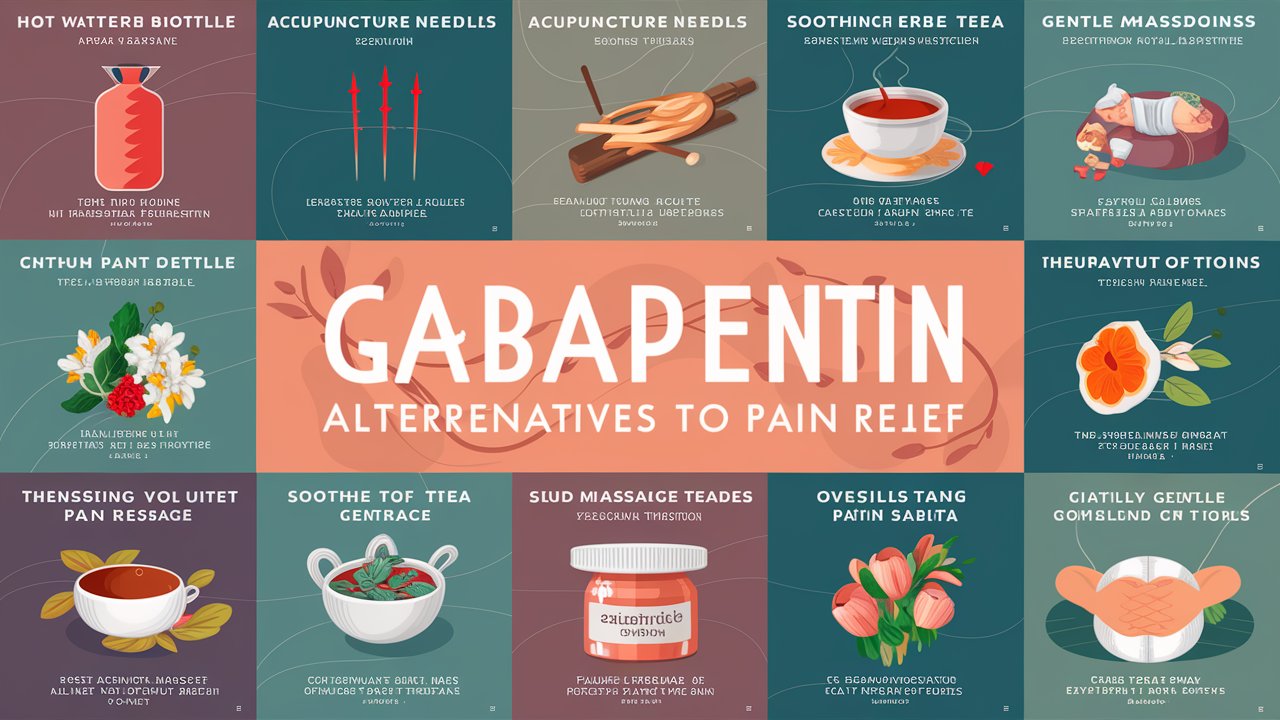Here is a table of 7 surprising alternatives to NSAIDs for pain relief, along with their pros and cons:
| Alternative | Pros | Cons |
|---|---|---|
| 1. Capsaicin | – Derived from chili peppers, it can block pain signals to the brain – Effective for treating muscle and joint pain caused by conditions like arthritis, sprains, and strains |
– May cause skin irritation or burning sensation initially
| 2. Acupuncture | – Ancient Chinese practice that may help reduce pain and inflammation |
– Effectiveness can vary, and more research is needed
| 3. Cognitive Behavioral Therapy (CBT) | – Can help patients develop coping strategies and change pain-related behaviors |
| – Requires commitment and may not provide immediate pain relief | |
| 4. Physiotherapy | – Exercises, stretches, and other therapies can improve mobility and reduce pain |
| – Requires regular sessions and commitment from the patient | |
| 5. Omega-3 Fatty Acids | – Found in fish oil, they have anti-inflammatory properties and may help reduce pain |
| – It may take several weeks to see the full benefits | |
| 6. Topical Creams/Gels | – Topical NSAIDs can provide localized pain relief with fewer systemic side effects |
| – May not be as effective as oral NSAIDs for widespread or severe pain | |
| 7. Acetaminophen | – Targets pain rather than inflammation, making it a safer alternative to NSAIDs |
– Does not have the same anti-inflammatory effects as NSAIDs.
In a world where options for pain relief often boil down to a single pill bottle, the allure of exploring alternatives to NSAIDs has never been more enticing. Picture this: stepping away from the cookie-cutter solutions and delving into a realm of surprising remedies that promise relief without the unwanted side effects.
As chronic pain sufferers increasingly turn their gaze towards natural and drug-free modalities, a shift in mindset emerges—one that advocates for holistic approaches over quick fixes.
The wave of curiosity surrounding alternative pain management methods is palpable, with individuals seeking avenues beyond the traditional NSAIDs echoing a collective sentiment of empowerment through choice.
Embracing diverse perspectives and shedding light on unconventional possibilities becomes not just an act of defiance against the norm but also an avenue for self-discovery and enhanced well-being.
As we navigate this journey together, armed with information as our compass and openness as our guide, let’s embark on a playful yet purposeful exploration of seven unexpected lifelines that could redefine how we perceive—and alleviate—pain.
Let’s set sail towards understanding these ‘alternatives’ not merely as deviations but as revelations waiting to unravel new chapters in our pursuit of perpetual comfort and vitality.
Herbal Remedies: Nature’s Anti-inflammatory Allies.
Imagine finding relief from your chronic pain through remedies straight from the earth. Herbal alternatives like turmeric and ginger have been nature’s hidden gems for centuries, offering a beacon of hope for those seeking to break free from NSAIDs’ side effects.
Turmeric, with its active ingredient curcumin, packs a powerful punch against inflammation, providing similar benefits to traditional pain relievers but without the digestive issues or potential harm to the liver that can come with NSAIDs.
Ginger, on the other hand, not only adds zest to your cooking but also contains compounds that exhibit anti-inflammatory properties comparable to those found in nonsteroidal anti-inflammatory drugs.
These herbal remedies don’t just mask symptoms; they work harmoniously with your body’s natural processes to target the root cause of pain. By taking a step into the world of herbal medicine, you empower yourself to discover ancient wisdom that offers gentle yet effective solutions.
Embracing such alternatives isn’t just about choosing different ingredients—it’s about adopting a holistic approach that listens to what your body truly needs. So next time you reach for a bottle of pills, pause and consider the wonders nature has provided in these humble herbs.
In this journey toward natural healing, curiosity is your best companion. Explore how incorporating turmeric tea into your daily routine or adding fresh ginger to salads can infuse your life with vibrant flavors and potent health benefits.
Let these herbs be more than mere condiments; let them be allies in your pursuit of pain relief without compromise. As you venture into this world of herbal alternatives, remember that sometimes the most surprising solutions are rooted in traditions that have withstood the test of time—not in synthetic pills manufactured by modern science.
Acupuncture and Acupressure: Alternative Pathways to Pain Relief.
Have you ever wondered about the ancient art of acupuncture and acupressure as potent alternatives to traditional pain medications? These holistic practices delve into the body’s energy pathways, aiming to restore balance and alleviate discomfort naturally.
Acupuncture involves inserting thin needles into specific points on the body, while acupressure relies on applying pressure to these areas. Both methods target trigger points associated with pain, promoting circulation, and releasing tension.
In the realm of long-term effectiveness, acupuncture and acupressure offer a compelling alternative narrative compared to NSAIDs. While NSAIDs provide temporary relief by blocking pain signals, acupuncture and acupressure address the root cause of pain by stimulating the body’s natural healing mechanisms.
Think of it as a gradual but profound shift towards sustainable pain management without the risk of side effects commonly linked with NSAIDs. By considering these modalities, chronic pain sufferers can explore new avenues for relief that prioritize overall well-being.
Imagine a world where your journey toward pain management is not just about numbing symptoms but about fostering genuine healing from within. Acupuncture and acupressure open doors to personalized care that goes beyond conventional approaches, inviting individuals to tap into their body’s innate ability to find balance and harmony.
These alternative therapies beckon us to embrace a paradigm shift in how we perceive and address pain – not merely as an ailment to be subdued temporarily but as a signal guiding us towards holistic wellness.
Physical Therapy: A Proactive Path to Pain Management.
When seeking relief from chronic pain, physical therapy emerges as a proactive alternative that empowers individuals to address the root causes of discomfort without solely relying on NSAIDs. Through a customized regimen of therapeutic exercises and stretches, physical therapy not only targets the immediate symptoms but also fosters long-term improvements in mobility and reduced pain perception.
Unlike quick-fix solutions like NSAIDs, physical therapy aims to enhance overall wellness by addressing muscle imbalances, joint stiffness, or postural issues contributing to persistent pain.
Imagine waking up with less stiffness in your joints or being able to move more freely throughout your day – these are some common benefits individuals experience through consistent participation in physical therapy sessions.
By engaging in targeted exercises under the guidance of trained professionals, patients can gradually build strength, flexibility, and endurance tailored to their specific needs. This personalized approach not only reduces reliance on temporary pain relief methods but also equips individuals with tools to actively manage their discomfort and prevent future flare-ups.
Moreover, what sets physical therapy apart is its holistic focus on enhancing functional abilities and improving quality of life beyond just alleviating pain symptoms. Rather than masking the issue temporarily with NSAIDs, physical therapy delves into correcting movement patterns and strengthening muscles to provide lasting relief.
Through this alternative approach, individuals can embrace an active role in their healing journey and cultivate resilience against chronic pain without compromising their overall well-being.
Mindfulness Practices for Pain Relief.
Mindfulness practices like yoga and meditation offer more than just a moment of calm—they can also play a significant role in managing chronic pain. By emphasizing the mind-body connection, these techniques help individuals ease their pain perception and cultivate a sense of control over their physical well-being.
Through mindful movements in yoga or focusing attention during meditation, people can learn to redirect their awareness away from discomfort, thereby reducing the impact of pain on their daily lives. This approach empowers individuals to actively participate in their healing journey without relying solely on NSAIDs or other medications.
Countless stories abound of individuals who have experienced remarkable relief from chronic pain through mindfulness practices. Take Sarah, for example, who struggled with fibromyalgia for years and found traditional pain medications ineffective.
Upon integrating a daily mindfulness routine into her life, including gentle yoga sessions and guided meditations focused on relaxation, Sarah noticed a tangible decrease in her pain levels. Over time, she was able to reduce her reliance on NSAIDs and regain a sense of freedom from constant discomfort.
Sarah’s experience showcases the transformative power of mindfulness as a non-invasive alternative that works holistically to address both physical symptoms and emotional well-being.
Comparing the invasive nature of NSAIDs with the gentle yet profound effects of mindfulness practices highlights the importance of exploring alternative avenues for pain relief. While pharmaceuticals often come with side effects and risks, mindfulness techniques present a safe and empowering option that encourages self-awareness and self-care.
By tapping into one’s inner resilience and leveraging the healing potential within oneself, individuals can break free from the cycle of dependency on conventional medications. Embracing mindfulness not only offers tangible benefits for pain management but also fosters a deeper connection with one’s body and mind, laying the foundation for long-lasting well-being beyond just symptom relief.
Diet and Nutrition for Pain Relief:
When it comes to managing pain, what you eat can play a significant role in how you feel. A balanced diet rich in anti-inflammatory foods can be a surprising yet powerful alternative to NSAIDs for pain relief. Foods like fatty fish, leafy greens, berries, nuts, and olive oil are packed with nutrients that can help reduce inflammation in the body, thereby alleviating pain symptoms.
By incorporating these anti-inflammatory foods into your daily meals, you are not only nourishing your body but also working towards easing your discomfort naturally.
Making dietary changes as an alternative strategy to solely relying on NSAIDs empowers individuals to take control of their health and well-being. Rather than just masking the pain with medication, focusing on improving your diet can address the root cause of inflammation that contributes to chronic pain.
It’s intriguing how a simple shift in what you eat can have profound effects on how you feel physically. By embracing this alternative approach, you are opening doors to explore new possibilities for managing your pain without depending solely on conventional medications.
Imagine starting your day with a refreshing smoothie filled with anti-inflammatory ingredients like spinach, turmeric, and pineapple or enjoying a colorful salad bursting with berries and walnuts for lunch – these culinary adventures not only offer delicious flavors but also serve as potent tools in fighting inflammation and discomfort.
The journey towards using food as medicine opens up a world of flavorful alternatives that not only nourish your taste buds but also support your body in ways that extend beyond temporary relief provided by NSAIDs. Embracing the transformative power of nutrition allows individuals to tap into a holistic approach that addresses their pain from the inside out.
Cold Therapy and Heat Therapy: Therapeutic Temperature Relief.
When it comes to managing pain, the comforting embrace of cold therapy and the soothing warmth of heat therapy can offer remarkable relief without the need for NSAIDs. Cold therapy, often known as cryotherapy, involves applying ice packs or cold compresses to the affected area.
This approach is particularly effective in reducing inflammation and numbing pain, making it a valuable alternative for those seeking localized relief from injuries or chronic conditions. On the other hand, heat therapy works by improving blood flow and relaxing muscles, helping to alleviate stiffness and discomfort in joints or muscle spasms.
To make the most of cold therapy at home, consider using gel packs or frozen vegetables wrapped in a towel to prevent direct contact with the skin. Applying these cold compresses for short periods can significantly reduce swelling and ease acute pain.
In contrast, heat therapy options like heating pads or warm baths provide a gentle way to relax tight muscles and enhance flexibility. By alternating between cold and heat therapies based on your specific needs, you can tailor your pain management approach effectively without relying on NSAIDs’ potential side effects.
Whether you are dealing with post-workout soreness or chronic back pain, exploring the benefits of temperature-based therapies opens up a world of natural alternatives that are empowering and accessible.
Embrace the versatility of cold and heat treatments in targeting different types of pain – from sharp injuries to persistent discomfort – while creating a personalized regimen that suits your preferences. Remember that these therapies not only offer physical relief but also serve as holistic solutions that promote self-care and well-being beyond traditional medications.
Exploring Diverse Paths to Pain Relief.
As we wrap up our journey through the realm of surprising alternatives to NSAIDs for pain relief, it’s essential to reflect on the empowering possibilities that lie beyond traditional medication.
By delving into herbal remedies like turmeric and ginger, engaging in practices such as acupuncture and acupressure, embracing mindfulness techniques, adjusting dietary habits, and incorporating temperature-based therapies like cold and heat therapy, we’ve unearthed a rich tapestry of options at our disposal.
In our quest for holistic well-being, let’s remember that each individual is unique, necessitating a personalized approach when navigating the landscape of alternatives. Embrace this newfound knowledge not as a limitation but as an invitation to explore diverse paths towards pain relief.
By combining different methods based on your preferences and needs, you have the power to chart a course towards wellness that speaks uniquely to you. So go forth with confidence, curiosity, and a sprinkle of playfulness – for the world of alternative pain management awaits your discovery!
I am commitment to crafting compelling narratives and delivering insightful content continues to inspire and inform readers across various platforms. Explore her articles on AlternativesZone.com and FactAfterFact.com to experience a rich tapestry of knowledge and discovery. Here I Analyze and Test the products and services together with my team before we recommend them to our users. Nice Reading Here!











